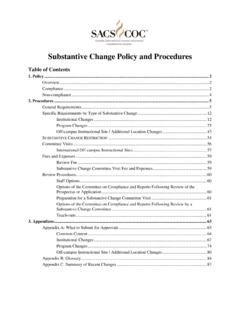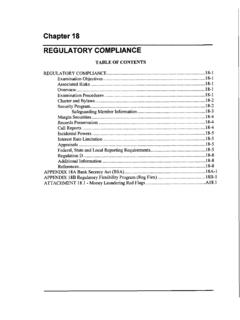Transcription of Therapy Manuals For Drug Addiction. Manual 1
1 IiiACKNOWLEDGMENTSThe development of earlier versions of this Manual was supported by several research grants fromthe National Institute on Drug Abuse. The current Manual was written by Dr. Kathleen Carroll ofYale University under Contract Number N-OIDA-4-2205 with the National Institute on Drug Lisa Onken, the NIDA Project Officer, offered valuable guidance and comments throughout thepreparation of this material presented in this Manual is the result of a program of research by Dr. Kathleen Carrolland Dr. Bruce Rounsaville and their colleagues at Yale University.
2 The development of this therapymodel for treatment of drug abuse drew extensively from the work of Alan Marlatt and others(Marlatt and Gordon 1985; Chancy et al. 1978; Jaffe et al. 1988; Ito et al. 1984). The structure andsequence of sessions presented in this Therapy model was partially developed by work on ProjectMATCH published by the National Institute on Alcohol Abuse and Alcoholism (Kadden et al. 1992)and the Manual developed by Peter Monti and his colleagues (1989). These sources are particularlyreflected here in the a skills-training material, and we have acknowledged the original sources ineach of those University Research TeamDisclaimerThe opinions expressed herein are the views of the author and do not necessarily reflect the officialpolicy or position of the National Institute on Drug Abuse or any other part of the Departmentof Health and Human Domain NoticeAll material appearing in this report except the forms (Exhibit 9, Exhibit 13 and Exhibit 14)
3 Is in thepublic domain and may be reproduced without permission from the National Institute on Drug Abuseor the author. Citation of the source is Institute on Drug AbuseNIH Publication Number 98-4308 Printed April 1998 Coinvestigators:Bruce Rounsaville, Nich, Ball, Fenton, Gawin, Kosten, McCance-Katz, , Ziedonis, staff:Meghan Brio, Bisighini, Canning-BallJoanne Corvino, CoxLynn Gordon, Frankforterjenniffer OwlerTherapists:Michael Barrios, Keller, Grunebaum, than 20 years of research has shown that addiction is clearly treat-able.
4 Addiction treatment has been effective in reducing drug use and HIVinfection, diminishing the health and social costs that result from addic-tion, and decreasing criminal behavior. The National Institute on DrugAbuse (NIDA), which supports more than 85 percent of the world sresearch on drug abuse and addiction, has found that the most effectivetreatment approaches include both biological and behavioral ensure that treatment providers apply the most current science-basedapproaches to their patients, NIDA has supported the development of the Therapy Manuals for Drug Addiction series.
5 This series reflects NIDA scommitment to rapidly applying basic findings in real-life settings. Themanuals are derived from those used efficaciously in NIDA-supporteddrug abuse treatment studies. They are intended for use by drug abusetreatment practitioners, mental health professionals, and all others con-cerned with the treatment of drug Manuals present clear, helpful information to aid drug treatmentpractitioners in providing the best possible care that science has to describe scientifically supported therapies for addiction and givespecific guidance on session content and how to implement these tech-niques.
6 Of course, there is no substitute for training and supervision, andthese Manuals may not be applicable to all types of patients nor compat-ible with all clinical programs or treatment approaches. These manualsshould be viewed as a supplement to, but not a replacement for, carefulassessment of each patient, appropriate case formulation, ongoing moni-toring of clinical status, and clinical therapies presented in this series exemplify the best of what wecurrently know about treating drug addiction. As our knowledge evolves,new and improved therapies are certain to emerge.
7 We look forward tocontinuously bringing you the latest scientific findings through manualsand other science-based publications. We welcome your feedback aboutthe usefulness of this Manual series and any ideas you have on how itmight be I. LeshnerDirectorNational Institute on Drug AbuseForewordivBLANK PAGEvForeword ..iiiCognitive-Behavioral Therapy : An Overview ..1 Why CBT? ..1 Components of CBT ..2 Functional Analysis ..2 Skills Training ..2 Critical Tasks ..3 Parameters of CBT ..4 Format ..4 Length ..4 Setting.
8 5 Patients ..5 Compatibility With Adjunctive Treatments ..6 Active Ingredients of CBT ..6 Essential and Unique Interventions ..7 Recommended But Not Unique Interventions ..7 Acceptable Interventions ..8 Interventions Not Part of CBT ..8 CBT Compared to Other Treatments ..8 Similar Approaches ..8 Cognitive Therapy ..9 Community Reinforcement Approach ..9 Motivational Enhancement Therapy ..9 Dissimilar Approaches ..10 Twelve-Step Facilitation ..10 Interpersonal Psychotherapy ..11 Basic Principles of CBT ..13 Learned Behavior.
9 13 Modeling ..13 Operant Conditioning ..13 Classical Conditioning ..14 ContentsviFunctional Analysis ..14 Deficiencies and Obstacles ..14 Skills and Strengths ..14 Determinants of Cocaine Use ..15 Relevant Domains ..15 Assessment Tools ..16 Skills Training ..17 Learning Strategies Aimed at Cessation of Cocaine Use ..18 Generalizable Skills ..19 Basic Skills First ..19 Match Material to Patient Needs ..19 Use Repetition ..20 Practice Mastering Skills ..22 Give a Clear Rationale ..22 Get a Commitment ..22 Anticipate Obstacles.
10 23 Monitor Closely ..23 Use the Data ..24 Explore Resistance .. 24 Praise Approximations ..24 The Structure and Format of Sessions ..2520/20/20 Rule .. 25 First Third of Session ..26 Assess Patient Status ..26 Urine Tests ..26 Problem Solving ..28 Listen for Current Concerns ..28 Discuss the Practice Exercise ..29 Second Third of Session ..29 Introduce the Topic ..29 Relate Topic to Current Concerns ..30 Explore Reactions ..30 Final Third of Session ..31 Assign a Practice Exercise ..31 Anticipate High-Risk Situations.






